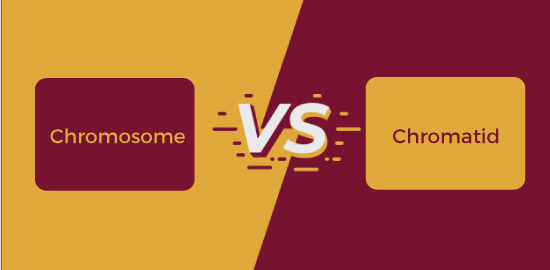Difference between Chromosome and ChromatidThere are a variety of organisms present on this earth. Plants, humans, and animals have their way of living. Some feed on the surroundings, some on dead flesh, while some consume both of them. Every creature in the surroundings depends upon one another for food, nutrients, proteins, water, etc. It is interesting to note that every organism is made up of cells and these cells have a nucleus. All organisms contain the genetic material that helps in their sustenance. There are two kinds of thread-like structures present in an organism. They are chromosomes and chromatid. They both ensure the process of cell division. Well, there are several points of contrast between them. But let us start by defining these two terms. 
ChromosomeA chromosome is defined as a thread-like formation which is present in the cell's nucleus. The chromosomes are majorly made up of proteins and nucleic acids that comprises of genetic information. Chromosome has been taken from the Greek word wherein 'chroma' means color and 'soma' means body. This term was first coined by Heinrich Wilhelm Waldeyer. A chromosome contains DNA and proteins that are organized into genes. Interestingly, every cell has 23 pairs of chromosomes. Chromosomes are made of DNA molecules. This DNA is tightly packed around proteins. This coiling is known as histones. Histones help in supporting the structure of chromosomes. One of the common examples of a chromosome is the 'X' and 'Y' chromosomes that determine whether one will be a girl or a boy. There are two significant kinds of chromosomes, i.e., allosome (sex chromosome) and autosomes (body chromosome). Now, here arises a question, i.e., how much DNA is present in a chromosome? Well, there are 100 million base pairs of DNA in chromosomes. Each chromosome has hundreds of nucleosomes that are linked with DNA. In humans, females tend to inherit the 'X' chromosome from both the parents, whereas males tend to inherit the 'Y' chromosome from their father and the 'X' chromosome from their mother. The human body consists of 46 molecules of DNA. All the human chromosomes exist in pairs that are identical in nature. Interestingly, the number of chromosomes varies in different organisms. For instance, in plants, bread wheat has 42 chromosomes, and durum wheat has 28 chromosomes. Similarly, in animals, the Tibetan fox has 36 chromosomes, while the domestic cat and pig have 38 chromosomes each. ChromatidChromatid is defined as the thread-like structure wherein the chromosome is divided longitudinally. The cell division takes place in chromatids. Biologically, chromatids are two identical halves of the replicated chromosomes. In DNA replication, identical structures called chromatids are present in chromosomes. Chromatids are linked at the centromere. Chromatids are seen in the early steps of cell division, after which they segregate so that they can become separate chromosomes. Interestingly, every pair of chromosomes comprises of four chromatids. This is called a bivalent or a tetrad. A pair of chromatids is called a dyad. Sister Chromatid Exchange (SCE) takes place in chromatids. It is the process of the exchanging the genetic information among the two chromatids. This process majorly occurs during meiosis or mitosis. The chromatid pairs are quite identical and are considered to be homozygous. However, they represent some differences during the process of mutation. In such cases, they become heterozygous. It is interesting to note that chromatids can be non-sister or sister chromatids. The non-sister chromatids are the homologous chromosomes. In this kind, the maternal chromosome and the paternal chromosome are paired. Now, chromosomes and chromatids have certain differences between them. So, let us have a look at them.
So, these are some of the contrasting points regarding chromosomes and chromatids. Now, there are several features of chromatids and chromosomes. So, let us discuss them. Features of Chromosomes
Features of Chromatids
So, these are some of the features of chromosomes and chromatids. Both of them are present in the cell's nucleus and are responsible for a variety of processes. They help in managing cell death and cell division. Thus, both chromatids and chromosomes are an essential part of the cell.
Next TopicDifference between
|
 For Videos Join Our Youtube Channel: Join Now
For Videos Join Our Youtube Channel: Join Now
Feedback
- Send your Feedback to [email protected]
Help Others, Please Share










